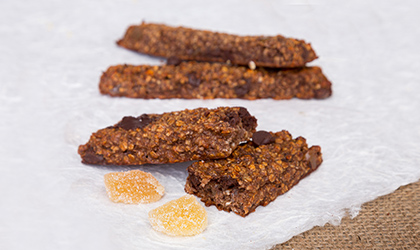
The throbbing. The hammering. The piercing. Migraines can very quickly ruin your day and send you crawling back to bed – curtains drawn, ice pack on head, and eyes tightly shut. Migraines aren’t your usual headaches. If you’ve ever experienced them, you’ll know they’re characterised by nausea, light and sound sensitivity, and – of course – that relentless pounding pain in your head. And when it hits, you’ll do just about anything to make it stop. Thankfully, your only option isn’t popping over-the-counter painkillers. There are plenty of natural and holistic ways to prevent migraines, or at least, ease the pain when they do attack.
Let go with lavender
Essential oils have demonstrated great promise when it comes to migraine management. But the real showstopper? Why lavender, of course – an age-old remedy that’s often used for incidences of anxiety and stress. In a small study published by European Neurology, researchers found individuals who inhaled this oh-so-soothing essence for approximately 15 minutes during a migraine attack, experienced faster relief than their counterparts who inhaled the placebo i. You can inhale lavender directly or apply a small-diluted amount on your the temples when a migraine strikes.
Go for ginger
Migraines aren’t just notorious for triggering those ear-splitting headaches; they’re known for making your stomach churn, too. This is where the ‘spice of life’, ginger, comes in. Heralded for it’s anti-nausea credentials, this herbal hero is thought to soothe sickness associated with migraines. To make your own anti-migraine tea, mix one-eighth of a teaspoon of ground ginger with hot water. You could also use fresh ginger root in the mixture.
Add more magnesium
A magnesium deficiency is often linked to migraines and headaches iii. In fact, one study found that regular intake of this mighty mineral reduced the frequency of migraine attacks by 41.6% – almost half iv. Use food as your medicine to attain the recommended 400mg/day, of which a Western diet supplies much less. Thankfully, magnesium is abundant in plenty of nutrient-dense foods. Load up on leafy green veggies, like kale and spinach, nuts and seeds, unrefined whole grains and brown rice, oats and bananas. Top tip: calcium helps with the absorption of magnesium, so try partnering these foods with dairy products, edamame, tofu, sardines, etc.
Diet no-no’s
Long-term solutions to health conditions always require fine-tuning your diet – and migraines aren’t an exception. That being said, there’s no ‘one-size-fits-all’ nutritional regimen for preventing and easing migraines; everyone experiences different sensitivities. Sometimes it can help to keep a migraine journal or food diary to better understand your potential triggers. Common migraine-inducing foods include alcohol, especially red wine; chocolate; caffeinated beverages; processed foods; pickled foods; dried fruits; foods that are very cold, like ice-cream; and cheese that contains the naturally-occurring compound tyramine, such as feta, blue cheese, Swiss and Parmesan.
Quench your thirst
Sure, this advice may sound obvious and overused, but that’s only because it’s true. Dehydration is a common culprit in the development of minor headaches; so imagine the role it plays in severe migraines. The solution is very simple: drink up! Aim to quench your thirst with 8-10 large glasses of water every day. And if straight-up H20 doesn’t do it for you, add sliced lemon, cucumber and berries to encourage you to guzzle more.
Sign up to yoga
The ancient practice of postures, meditation and breathing won’t just keep you supple and zen, new research proposes it may relieve the duration and severity of migraines, too. Advocates of yoga believe it can reduce muscle tension and blood flow, and thereby support the reduction of symptoms associated with migraines v. Yoga is abundant in tension-releasing postures, but here’s a simple one to jumpstart your efforts: ‘savasana’ (i.e. corpse pose). Lay on your back with your feet and legs fairly close together. Allow your feet to fall towards the side. Place your arms 30 degrees away from your body, with your palms facing up. Keep your eyes closed and focus on relaxing your entire body. Savour the stillness and tranquillity.
Slash your stress
We all know stress is a bad news for our body. And like certain foods, stress may also spark and intensify migraines. The best way to break this vicious cycle is finding a productive outlet to alleviate such a toxic, all-consuming emotion. Journaling, meditation and exercise are some of the best weapons in your arsenal. Using essential oils and soaking in a long, hot bath may help, too. By equipping yourself with a slew of coping mechanisms, you’ll start taking control of your body responses to stress. And, as a result, you may prevent future migraines from occurring.
Acupressure is A-OK
Acupressure is the practice of applying pressure to specific points in the body to release muscle tension and ease the pain. According to a systematic review in Pain Management Nursing, acupressure is now thought to be a helpful tool for migraine sufferers vi. One popular pressure point to support the reduction of head pain is the LI-4 point – the space between the base of the pointer finger and left thumb. Apply firm (not painful) circular pressure to the LI-4 point with the opposite hand for around 5 minutes, and see if it provides you with some relief.
Catch z’s
Proper sleep is the cornerstone of optimal health and the secret to keeping migraines a bay. Too little or too much sleep can trigger that pounding head pain. Aim for 7-9 hours of restorative slumber every night. Struggling to clock off? Try to establish healthy bedtime rituals and make a conscious effort to stick to them; it could be practising yoga, meditating for 10 minutes, having a bath, or reading a book. Make a point of going to bed and waking at the same time every day, too. Oh, and as for that four o’clock cuppa joe – forget it. Drinking caffeine past 2 pm will only interfere with your quest for rest. Finally, turn off the tech! Make your bed a place for sleeping – nothing more. No Instagram. No Netflix. And no late-night work emails.
Calm with a compress
Don’t underestimate the healing power of a good old-fashioned compress on your head or neck when a migraine strikes. In one small clinical study conducted by the University of California, San Diego Medical Centre, 76% of participants experienced some relief from an ice pack during a migraine attack vii. That said, there’s no hard and fast rule about whether a compress should be hot or cold – both have reported working for migraine sufferers. Ice packs generate a numbing sensation, which may dull the throbbing and piercing nature of the pain; while hot compresses relax tense muscles. Find what works for you and stick with it.
Final thoughts
The symptoms associated with migraines can wreak havoc with daily life; there’s nothing worse than a throbbing head and nausea getting in the way of work, social commitments and family. However, with the correct application, it’s very possible to ease the severity of migraines when they do strike. Another quick win is decoding your triggers. This will certainly help reduce the frequency of migraine attacks. As the old-adage goes, ‘prevention is better than cure’.
References:
-
Sasannejad, P., Saeedi, M., Shoeibi, A., Gorji, A., Abbasi, M. & Foroughipour, M. (2012). Lavender Essential Oil in the Treatment of Migraine Headache: A Placebo-Controlled Clinical Trial. European Neurology, 67(5), 288-291.
-
(2018). Magnesium May Be Effective for Migraine - The National Headache Foundation. The National Headache Foundation Available online: https://headaches.org/2018/01/16/magnesium-may-effective-migraine [Accessed 24 Oct. 2018]
-
Peikert, A., Wilimzig, C. & Köhne-Volland, R. (1996). Prophylaxis of Migraine with Oral Magnesium: Results From A Prospective, Multi-Center, Placebo-Controlled and Double-Blind Randomized Study. Cephalalgia, 16(4), 257-263.
-
Boroujeni, M.Z., Marandi, S.M., Esfarjani, F., Sattar, M., Shaygannejad, V. & Javanmard, S.H. (2015). Yoga intervention on blood NO in female migraineurs. Advanced biomedical research, 4, 259.
-
Chen, Y. & Wang, H. (2014). The Effectiveness of Acupressure on Relieving Pain: A Systematic Review. Pain Management Nursing, 15(2), 539-550.
-
Icedown.com (2018) Migraine Relief: Migraine Pain Treatment – Clinical Study.Available online: https://www.icedown.com/Articles.asp?ID=315 [Accessed 24 Oct. 2018]
You Might Also Like

Olivia
Olivia Salter has always been an avid health nut. After graduating from the University of Bristol, she began working for a nutritional consultancy where she discovered her passion for all things wellness-related. There, she executed much of the company’s content marketing strategy and found her niche in health writing, publishing articles in Women’s Health, Mind Body Green, Thrive and Psychologies.
View More



